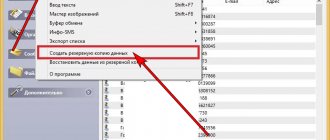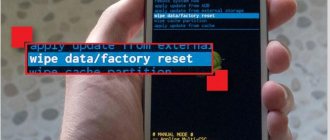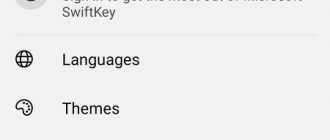by Yuri Belousov · 05.29.2017
Most users of phones and tablets running the Android operating system are familiar with the concept of a widget - an interactive element of the system shell of various services, in other words, shortcuts and icons on the desktop. Widgets are designed for the convenience of the user, but often become boring and disturb the user. This article tells you how to remove widgets from your Android phone's desktop . And also how to recover deleted widgets on Android.
How to remove an unnecessary widget from the desktop of an Android tablet or phone
Users often have no idea how easy it is to remove an unnecessary widget from the desktop of an Android tablet or phone. For example, let's look at how to remove a weather widget from your phone screen:
- You need to click on the weather widget and, without releasing it, wait until it becomes unstuck from its location;
- Drag the weather widget to the top of the screen, onto the “Delete” message that appears or the trash can icon;
- That's all, in this way you can remove an unnecessary weather widget from the screen of your phone or tablet.
Naturally, in this way you can remove the Yandex widget, Google (Google search widget), Samsung and in general any widget and shortcut from the desktop or from the menu of a tablet or phone.
In addition, you can remove widgets from the home screen and lock screen from Samsung and any Android device through the application manager.
Removing widgets
Well, you have installed what you wanted. But, for example, you didn’t like some of them or take up a lot of space on your desktop, and you want to remove a couple. Now we will tell you how to remove widgets from the Samsung screen. To do this, follow these instructions:
- To begin, select the widget you want to delete by holding your finger on it for about a second or two.
- A mode will be activated in which you can drag icons anywhere, but now we need to delete them. A trash can icon or “delete” message will appear at the top or bottom of the display (depending on the phone version or operating system).
- Drag the icon there and you're done.
- Now, to return to normal mode, simply click on an empty area of the screen.
Important! If you want to completely erase a widget from your phone, you need to delete the application of which it is a part. To remove built-in widgets, you will need Root rights.
Many actions such as updating software, transferring data, installing and deleting files, applications, and cleaning up malicious software can be performed much faster via a PC. Take note of our article with step-by-step instructions on how to connect your phone to a computer.
How to remove a widget from the Android desktop? Just like a shortcut. Press your finger on the widget, wait for the “Remove” command to appear, and drag the widget towards it.
How to recover a deleted widget on Android - return a deleted widget
To restore a deleted widget, you need to go to the Menu in the Widgets category, select the desired widget from those offered or previously deleted and drag it to an empty space on the screen of your phone or tablet.
An interesting video that explains how to work with shortcuts and widgets, as well as how to remove widgets from the desktop of your Android phone:
—>
By interacting with Android devices, we customize them to suit our needs. During use, application icons and widgets appear on the main screen. This article is a short lesson on interface elements. You will learn what widget applications are, how to add them, and also how to remove a widget on Android.
Let's turn to Wikipedia to determine the meaning.
A widget (also called: interface element , control element, control) is a graphical user interface primitive that has a standard appearance and performs standard actions.
Widgets can be divided into four groups:
- System - interface elements designed to control and manage the operating system as a whole and the state of its elements in particular. For example: battery charge indication, time, GSM network status, and so on.
- Extensions are additional controls and controls installed by the user. They usually end up on your device after installing applications. For example: graphical information about the weather, data on system security from antivirus, the amount of money in WebMoney virtual wallets after installing a similar application.
- Shells are a visual component, used as an addition to the installed shell. At the same time, in the Android OS you can change everything: from the design of icons on the desktop to the interface itself in the settings.
- Multifunctional - controls that contain several types of functional and visual information. For example: auto-rotate screen, Bluetooth indicator.
- Others are interface elements that are designed to decorate the gadget screen. Usually do not contain useful information.
Available UI extensions can be added as follows:
- Unlock the device and on the main screen, click on the empty area and hold for a few seconds.
- Go to the "Widgets" section.
- Select the one you need from the list and drag it to your desktop. To drag, pinch it with your finger, and while holding it, drag it to an empty area of the screen. You can also add by double clicking on the icon.
- You can move (or resize) on the desktop by holding the widget icon for a second.
Some widgets require initial setup. Once added to the desktop, the corresponding interface will open, such as with a double clock.
To remove a widget on Android from your desktop, press and hold the icon for a few seconds. A Delete button will appear at the top or bottom of the interface. Drag the icon there to clear it.
To remove a widget from a smartphone or tablet, you need to delete it in the Application Manager, in Settings.
Some widgets are tied to installed applications, so they are removed together.
System widgets or those associated with system applications cannot be deleted without Root rights.
When buying a smartphone, the user may be faced with the fact that it already has applications and programs installed by default that are not interesting to him and will never be used. Of course, this is intended by the manufacturer, who makes a profit from the sale of third-party software.
If the presence of third-party programs annoys you, then it is better to remove them.
Removing a widget
To remove a widget on Android from your desktop, press and hold the icon for a few seconds. A Delete button will appear at the top or bottom of the interface. Drag the icon there to clear it.
To remove a widget from a smartphone or tablet, you need to delete it in the Application Manager, in Settings.
Some widgets are tied to installed applications, so they are removed together.
System widgets or those associated with system applications cannot be removed without the presence of .
Our next lesson in the training course is devoted to how to clear your desktop of unnecessary shortcuts.
According to the latest data, almost 2 million applications have been downloaded in the Google Play digital store, most of which are free programs. At the same time, the functionality of applets extends from simple notepads and calculators to controlling household appliances in the house.
Naturally, it is extremely difficult for a mobile device user to resist downloading additional applications, even if he knows exactly what he wants to install. In this case, programs and widgets and “one-time” series begin to accumulate, increasing the number of desktops. Because of this:
- The desktop turns into a real dump of icons
- It's quite difficult to find the app you need in this dump
- Apps running in the background overload your battery and processor.
However, the functionality of the Android operating system allows you to properly clean up your phone’s desktop and get rid of the clutter of unnecessary shortcuts, widgets and additional work screens. There are 3 simple ways to do this:
How to delete an application?
There are two simple ways to remove a regular application:
- Quick removal . The shortcut of an unnecessary application should be held with your finger until a trash can with the inscription “delete” appears in the corner (a cross marked “remove” only means deleting the shortcut from the main screen). Next, you must agree to the deletion request.
Some programs require preliminary clearing of the used memory. You need to go to the memory/storage item and press the “clear cache/clear data” button.
The deletion will be completed and some of the device memory will be cleared.
Some applications do not appear in the standard list. In this case, you need to press the key in the upper right corner while in the list of installed programs and select “show system applications”. On Xiaomi smartphones this item is in the settings.
How to remove the circle from the screen of Honor or Huawei
So, in order to remove the white circle from the Honor or Huawei screen, you need to disable this function in the settings of the smartphone itself. To avoid making mistakes with this section, use the step-by-step instructions below:
- Open the settings.
- Go to the “System” section.
Go to the “System” section
- How to enable and configure voice search from Yandex and Google. What to do if voice search doesn't work
- Go to the subcategory “System navigation”.
Go to the subcategory “System navigation”
- Click on the “Navigation button” item.
Click on the item “Navigation button”
- Move the slider to the left next to the “Navigation button” line. After performing this action, the indicator should change its color from blue to gray.
Move the slider to the left next to the line “Navigation button”
As you can see, it is quite easy to clear the screen of a foreign circle. Even the most novice users of the Android operating system should not have any difficulties following this detailed guide.
Using the Application Manager
To make it easier to work with files, there are many assistant programs. The store offers a lot of managers that help you quickly view installed applications and remove them permanently.
Root Needed Application Manager
A simple and intuitive manager that allows you to manage files and applications. Superuser (root) permission is required to remove system applications.
System Application Manager
The program differentiates between applications installed by the user and system ones. This is useful for novice users and helps prevent the removal of important components, such as the program installer.
App Manager
The application allows you to safely remove installed applications. To access the device memory, you need to open the corresponding folder or search by name.
To remove standard programs built into the operating system, you must enable super rights (root) on the device. You need to be very careful when working with files. Root makes it possible to delete any file, which can lead to disruption of the smartphone.
How to remove MMS center virus?
Recently, a malicious program has become widespread that differs from others in its camouflage method. The file looks like a message settings application. The name may look like SMS_S, SMS MMS, MMS video and similar names.
The virus spreads most often through SMS messages or email.
It is strongly recommended not to open such messages. After clicking on the link, a program is installed on the phone that sends paid messages, collects personal information and performs other actions.
During installation, the virus receives administrator rights, with which you can block the device, hide messages, and restrict access to files.
To remove it, you need to switch to the safe mode of the device; you can start the smartphone in safe mode by holding down the power button until the shutdown icon appears. After this, you need to hold your finger on the shutdown symbol for a few seconds. The screen will ask you to enable Safe Mode. The user must agree.
After this, you need to go to the device settings and disable administrator rights for the infected file: settings - security - device administrators. In the list of programs that have access, we find the infected file and disable it. After this, the virus can be removed.
To send such viruses, the numbers of interested people are taken from free classifieds sites and corresponding messages are written.
All installed applications can be removed from the settings menu or using the application manager.
How to delete Hangouts?
Hangouts is a messaging app for exchanging messages between Google users. In our country, the popularity of this application is very low due to many universal analogues.
This application cannot be removed in the usual way.
You can disable the application in the following way:
- We find a list of installed applications in the menu.
- Let's go to the application.
- Open the storage and clear the cache.
- After this, you need to click the “disable” button.
- The program will not appear in the menu or in the list of active programs.
In the same menu, you can enable a preinstalled program if the owner decides to take advantage of its capabilities.
To completely remove it, you need to obtain root rights on the device and a file manager.
You need to find Hangouts in the list of installed programs and select “uninstall”. You can return a previously liquidated program by downloading it from the store.
How to remove a widget from the screen?
By installing an application, for example Yandex Money, a widget appears on the device. The interactive shortcut is designed to display the current state of the program, balance, weather forecast and other available information.
To add or remove an application widget, you need to do the following. Touch an empty space on the desktop and hold until a special menu appears.
Tap the "Widgets" icon. After this, a menu of available extensions opens.
You should select the widget, hold it and drag it to the desktop.
You can remove a widget from your desktop in the usual way:
- Touch it for a few seconds.
- Drag and drop the icon at the top of the screen.
To ensure correct operation and prevent malfunction of the device, it is recommended not to delete applications whose purpose the user is not sure of.
It is important to know that open root access may limit the operation of some applications, such as banking clients with built-in antivirus or security systems.
January 20, 2015
To attract more buyers to their products, many companies that produce mobile devices equip them with the latest functions and services so that the owner of the gadget feels comfortable. These functions include widgets - graphic objects that are located on the screen of a smartphone or tablet. They are designed to perform certain actions, display some information, or simply decorate the space used. However, often, many modern programs are not at all needed by ordinary users. Therefore, every consumer should have an idea of how to remove an Android widget and independently manage the availability of services.
Installing the necessary widgets
Before you remove something, you need to put it up first. So, to add the desired widget:
- Hold your finger on a place not occupied by other applications. After this, a special menu should appear. Often there are buttons “Wallpaper”, “Settings” and, in fact, “Widgets”.
- We select the latter, a new menu opens where the above icons are located.
- Next, just select the one you need and place it in a free space on your phone screen.
Important! Almost every user of modern gadgets likes to show their individuality in display design. And it’s much more pleasant when your gaze catches a personally pleasant picture or photo of a dear person. You may find the information useful.
What are they?
- System ones are widget applications that are designed to manage the installed operating system and evaluate running processes (for example, clock, battery status indicator, CPU load, power management).
- Extenders are widget applications that are an add-on; they display information from other running applications. Let's say that clicking on the antivirus program icon or the Web Money icon launches the application itself.
- Shells are additions to existing shells and have an attractive appearance.
- Multifunctional – widget applications that simultaneously provide several types of information or functions (for example, auto-rotate screen, Wi-Fi network indicator).
- Others are widget applications that are used to decorate the desktop.
Removing unnecessary applications from the desktop
Similar programs can be installed by the manufacturer. Most often, this is a standard set of low-functional applications and icons that do not decorate the screen. Many programs appear on the desktop if the user has installed any applications that he downloaded earlier.
It happens that the user is overzealous and places a lot of graphic modules on the screen himself, although he does not need them. To solve this problem, you need to know how to remove widgets from the screen. One simple operation will help with this.
You should perform several simple steps in the exact sequence:
- Select the widget you want to remove from the screen;
- Press it and hold it for a while, the “Trash” icon will automatically appear at the bottom or top of the screen;
- Move the selected icon to the trash icon (it will turn red) and release.
That's it, the program you no longer need will be deleted. Please note: by performing this sequence of actions, you will not remove the software from the device, but only remove it from the screen.
How to Move Android Widgets to Another Screen
As I promised in the introduction to the post, let's now see how to move Android widgets to another screen .
If you are not going to completely remove the widget from your home screen or remove it from your device, this is the only alternative that you can remove as an element of the Android home screen so to speak.
To continue, you must first go to the home screen page where the widget you want to move to another screen is located. At this point, all you have to do is place your finger on the element in question and hold it for a few seconds until you feel the device vibrate or in any case until you see the widget become editable.
At this point, drag the widget to the left or right edge of the screen (depending on whether you want to move it to the previous or next home screen page) and release it once you have determined the "corner".
If necessary, change the size of the element using the points you see around its perimeter (always, if possible) and tap the “blank” point on the main screen to save the changes made.
If there are no additional pages on the home screen where you can save the widget, the launcher's edit menu will open (usually just tap a dot on the screen with no icons) and tap the appropriate item, which may be represented by a symbol (+).
Have you seen that it wasn't actually that difficult to move widgets to a different screen on your home screen? Now all you have to do is repeat the operation for other widgets to better organize the screens on your device.
Or another option for designing a list of widgets.
How to remove an application from your device?
Let's look at how to remove widgets on Android. In order to free up memory on your smartphone or tablet, you need to completely remove unused widgets using Root rights. In essence, this is the same operation as deleting regular programs.
The situation is somewhat more complicated with the elimination of widgets and programs, since they are independent applications, so they should be disposed of separately. Let's say if you have the GO Launcher application installed, then to remove its widgets you need to open the list of applications and mark those programs that belong to the launcher (they start with the word GO).
Those users who use the Android 4.2 Jelly Bean operating system need to know how to disable widgets on Android with a similar version.
In this case, you can use special applications, for example, Lockscreen Policy, which have a special option for managing Android widgets (the program can be downloaded from the Google Play service). The program interface is simple and intuitive even for an inexperienced Android user. With it you can easily solve the problem of removing unnecessary programs.
Now you can independently get rid of unnecessary software not only from your desktop, but also from your Android device.
Click “Like” and read the best posts on Facebook 05/16/2019
You can remove the Google Search widget on almost any smartphone. However, the method may vary depending on the casing, which differs from manufacturer to manufacturer. In most cases, you can delete a Google Search widget just like any other. To do this, just hold your finger on the widget, then move it to the delete area (in some firmware it is located at the top) or click on the cross.
Another thing is that for some reason some vendors do not provide this option by default, forcing users to resort to compromise measures. One of these involves stopping Google completely.
How to install and remove widgets on Android
The reason for this instruction was questions from our readers. In general, even the simplest question should be reflected in a separate instruction in our FAQ, which I update as soon as possible, and today the question of this article will be installing and removing widgets from the Android desktop .
Installing a widget on your desktop
A widget is one of the Android desktop elements. There are widgets that are the implementation of the functions of an application, and there are simply widget applications that do not provide other functions. Do not confuse installing a widget on your desktop with installing an application. If you are interested in how to make the widget appear on your phone, you need to read the instructions on how to install applications on Android.
In many old and new versions of Android, as well as in many third-party launchers, in order to add a widget to your desktop, you need to make a long touch on any free space on any of your desktops (usually there are several of them). After this, a context menu similar to this will open:
Or another similar option
In this menu, select “Widgets” accordingly and get into the list of all available widgets on your smartphone.
Or another option for designing a list of widgets.
Depending on the operating system or launcher, the selected widget is added either immediately to a free space on the desktop, or it must be dragged to the required location with a long tap.
Widgets can have any installed application. If this application has several widgets, this will be visible in the list of widgets. Then, when you select an item in such an application, you will be asked to select one of the available ones. Usually these are different sizes of widgets.
Also, when adding a widget, any application may require you to enter additional settings or parameters for the widget. If there are no such parameters, the widget will be immediately added to the desktop. Otherwise, the window of the application itself will appear. For example, for the Color Note application widget you will need to select one of the existing notes or create a new one:
In Android version 4.0 and higher, widgets are placed in a separate tab in the application list. In order to install a widget on Android 4.x, you need to press the central button at the bottom of the screen (list of applications), and select the “Widgets” tab at the top of the screen (you can also scroll the screen to the right until the applications end and widgets begin).
Scrolling the screen left and right, select the desired widget, click on it and hold it, then drag it onto the desired screen of your smartphone with a finger movement. We select the most successful location, release your finger - the widget is placed in the location you selected on the screen.
In general, everything is simple. If you don't like the location where the widget has been added, you can drag it. To do this, you need to make a long touch on the widget, and without releasing your finger from the screen, drag it to another place.
Removing a widget from the desktop
In order to remove a widget from the desktop, you need to make a long tap (touch) on the widget, and drag it down to the trash icon or the “Delete” inscription (usually at the bottom or top of the screen), which appears there, and release it. The widget itself will turn red. It's simple. If you want to remove the widget from your smartphone altogether (so as not to take up space), you need to remove the application that creates it. If these are standard widgets, then Root rights will be required to remove them from the system.
It seems that I wrote everything in detail, if you have questions, ask or write to the forum . There we are guaranteed to answer everyone who writes.
Recently, such a thing as widgets has become quite popular in all operating systems. Have you spent several years in a cryogenic chamber and don’t know what strange graphic elements are on your Android smartphone? How to remove them or, conversely, add new ones? Then it’s worth learning more, learning how to manage them and, if necessary, being able to install or remove them.
How to remove Google from your desktop
- To do this, go to “Settings”;
- Open the “Applications” section and find the Google application there;
- Select it and in the window that opens, click “Delete”, if there is such a button, or “Disable”.
Most likely, a warning will appear on the screen about the undesirability of disabling the Google application due to possible failures that may occur in the operation of other services of the search giant. Our experience shows that you will not notice any fundamental differences after disconnecting. At least, unless you are a regular user of the Google app, all of the features are still available to you in the browser.
How did you get rid of the annoying widget? Tell us about it in our Telegram chat.
Sources used:
- https://goodquestion.ru/udalit-vidzhety-rabochego-stola-telefona-android/
- https://vr4you.net/89-how-to-delete-a-widget-on-android.html
- https://v-androide.com/instruktsii/rabota/kak-udalit-prilozhenie-na-androide.html
- https://protabletpc.ru/advice/udalenie-vidzheta-na-android.html
- https://androidinsider.ru/polezno-znat/kak-udalit-vidzhet-google-poiska-s-rabochego-stola-na-android.html
SHARE Facebook
- tweet
Previous articleHow to change DPI on Android? (change screen resolution, 3 ways)
Next articleHow to delete an application on Android Samsung











